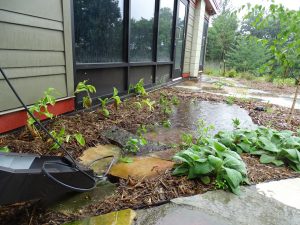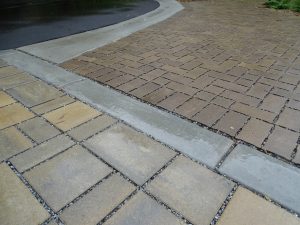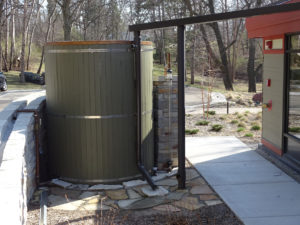Polluted runoff is the biggest threat to our lakes and creeks in urban areas.
You can take steps to manage polluted stormwater runoff on your property. By choosing to install a raingarden, lay permeable pavement, or harvest rainwater, you can reduce stormwater runoff and the amount of pollution getting to our lakes and creeks.
Raingardens
A raingarden is a shallow depression that can be planted with native plants and grasses. Raingardens are typically positioned near a runoff source like a downspout, driveway or street to capture stormwater runoff. Raingardens allow runoff to naturally soak into the ground, preventing the water from entering the storm drain system and flowing, untreated, to a local water body.
Benefits
- Promotes infiltration
- Reduces stormwater runoff
- Provides wildlife habitat
- Can reduce or eliminate erosion issues
Resources
Blue Thumb- Planting for Clean Water
What size raingarden do I need?
Permeable Pavement
Permeable pavement reduces the amount of stormwater runoff leaving a site by allowing it to soak into the ground, resulting in less pollution to local surface waters. There are several types of permeable pavement, including: pervious asphalt, pervious concrete, pervious pavers, and turf reinforcement systems.
Benefits
- Reduces stormwater runoff
- Promotes infiltration
- Reduces the amount of pollutants carried to stormdrains
- Reduces peak runoff volume and velocity
Resources
MN Stormwater Manual: Permeable Pavement
Rainwater Harvesting

Cisterns and rain barrels are two forms of rainwater harvesting. Rain is collected from hard surfaces, like rooftops, and stored for future use.
Rain barrels are usually placed at a downspout. They collect and store water for watering landscapes and garden plants. Cisterns are bigger, have greater storage capacity, and can be above or below ground. A general rule of thumb is that one inch of rainfall on a 1,000 square foot roof will yield approximately 600 gallons of runoff.
Benefits
- Reduces stormwater runoff
- Reduces the amount of pollutants carried to stormdrains
- Reduces peak runoff volume and velocity
- Protects water supplies by reducing use during peak summer months
